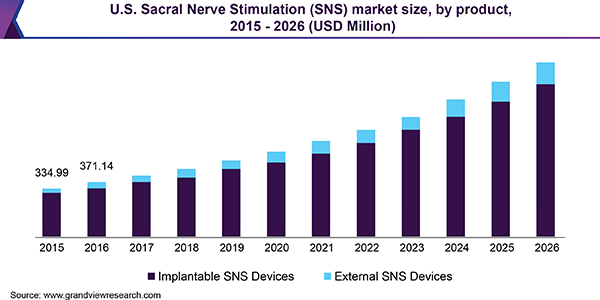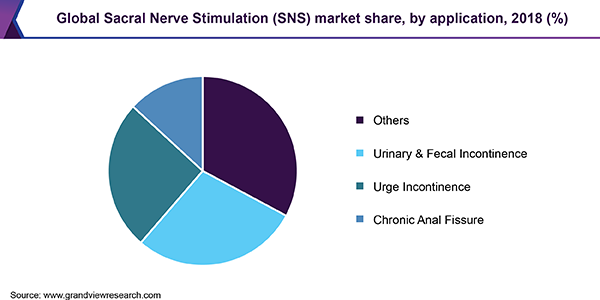- Home
- »
- Medical Devices
- »
-
Global Sacral Nerve Stimulation Market Size & Share Report, 2019-2026GVR Report cover
![Sacral Nerve Stimulation Market Size, Share & Trends Report]()
Sacral Nerve Stimulation Market Size, Share & Trends Analysis Report By Product (Implantable, External), By Region, By Application (Urge Incontinence, Urinary & Fecal Incontinence), And Segment Forecasts, 2019 - 2026
- Report ID: GVR-3-68038-132-0
- Number of Pages: 163
- Format: Electronic (PDF)
- Historical Range: 2015 - 2017
- Industry: Healthcare
Report Overview
The global sacral nerve stimulation market size was valued at USD 856.96 million in 2018 and is anticipated to expand at a CAGR of 13.7% over the forecast period. Increasing cases of urge incontinence, such as Urinary Tract Infection (UTI), and rising number of patients suffering from Overactive Bladder (OAB) and fecal incontinence are some of the key factors propelling the market growth.

Sacral nerve stimulation (SNS) is implanted as a device to control bladder functions by delivering controlled electrical impulses to the sacral nerves that modulate the neural pathways. It is an effective and safe treatment for patients suffering from fecal and urinary dysfunction. This treatment is recommended for patients who failed to get accurate result from therapy as well as medication.
According to the Center for Medicare and Medicaid Services (CMS), urinary incontinence affects around 13 million adults, mostly women, in U.S. SNS leads to significant improvement in enhancing the quality of life for affected individuals. Increasing incidence of fecal incontinence is also projected to boost the SNS market growth. It is one of the most devastating condition as it can impact the quality of life of an individual and even lead to social isolation.
According to the international neuromodulation society, one of the studies in the U.K. shows most of the geriatric population are affected by fecal incontinence. It is mainly dependent on lower elementary tract and nervous system, such as stool volume, mental function, consistency, colonic, sphincter and rectal function. Thus, increasing number of patients suffering from fecal incontinence will help drive the demand for SNS devices.
Product Insights
External SNS is expected to be the fastest-growing segment over the forecast period owing to increasing incidence of OAB and fecal incontinence. External devices generate electrical impulses to the sacral nerves to control the bladder. For instance, Axonics modulation technologies have designed an external SNS device for patients suffering from OAB.
Implantable devices segment led the market in 2018 and will maintain its dominance throughout the estimated period owing to increasing cases of urinary incontinence, pelvic pain, and fecal incontinence. This device is implanted through a needle without surgery, to control bladder function. This treatment is effective for patients suffering from urge incontinence. Increasing number of patients suffering from UTI and urge continence is driving the segment growth.
Application Insights
Urinary and fecal incontinence is expected to be the fastest-growing as well as largest segment over the forecast period. This growth can be attributed to the increasing number of patients suffering from UTI, OAB, and anal sphincter injuries. Fecal incontinence is due to the factor, such as obstetric trauma, fecal impaction, mainly in elder people, and iatrogenic injury from surgery.

Increasing prevalence of urinary and fecal incontinence is driving the growth of this segment. Neuromodulation is an effective treatment for urinary frequency, urgency, and urge incontinence. Thus, rising number of patients suffering for pelvic pain and constipation is driving the SNS market.
Regional insights
North America led the market and is projected to expand further at a strong CAGR due to increasing awareness about the treatment, prevalence of OAB and urge incontinence and presence of well-established healthcare facilities in the region. Moreover, quick adoption of technologically advanced medical products, such as implantable SNS devices, is also expected to drive the market in this region. In addition, increasing reimbursements for innovations in devices and treatment procedures is positively affecting the growth of the regional sacral nerve stimulation market.
Asia Pacific is estimated to expand at the highest CAGR from 2018 to 2026 due to increasing number of patients suffering from fecal incontinence and urinary incontinence. In addition, various awareness programs by the NGOs will help boost the product demand. Presence of a large number of key companies in economies, such as China and Japan, is also driving the market.
Sacral Nerve Stimulation Market Share Insights
Some of the key companies in the market include Medtronic PLC; Axonics Modulation Technologies, Inc.; Nuvectra; and Cogentix Medical. These companies focus on the development of new types of TMS system, technological advancements, and growth strategies, such as mergers and acquisitions to strengthen their industry position.
Sacral Nerve Stimulation Market Report Scope
Report Attribute
Details
Market size value in 2020
USD 1.1 billion
Revenue forecast in 2026
USD 2.39 billion
Growth Rate
CAGR of 13.7% from 2019 to 2026
Base year for estimation
2018
Historical data
2015 - 2017
Forecast period
2019 - 2026
Quantitative units
Revenue in USD million and CAGR from 2019 to 2026
Report coverage
Revenue forecast, company share, competitive landscape, growth factors and trends
Segments covered
Product, application, region
Regional scope
North America; Europe; Asia Pacific; Latin America; MEA
Country scope
U.S.; Canada; Germany; U.K.; France; Italy; Spain; Russia; China; Japan; India; Australia; South Korea; Singapore; Brazil; Mexico; Argentina; Colombia; South Africa; Saudi Arabia; UAE
Key companies profiled
Medtronic PLC; Axonics Modulation Technologies, Inc.; Nuvectra; Cogentix Medical
Customization scope
Free report customization (equivalent up to 8 analysts working days) with purchase. Addition or alteration to country, regional & segment scope.
Pricing and purchase options
Avail customized purchase options to meet your exact research needs. Explore purchase options
Segments Covered in the ReportThis report forecasts revenue growth at global, regional, and country levels and provides an analysis of the latest industry trends in each of the sub-segments from 2015 to 2026. For the purpose of this study, Grand View Research has segmented the global sacral nerve stimulation market report on the basis of product, application, and region:
-
Product Outlook (Revenue, 2015 - 2026 (USD Million))
-
Implantable
-
External
-
-
Application Outlook (Revenue, 2015 - 2026 (USD Million))
-
Urinary & Fecal Incontinence
-
Urge Incontinence
-
Chronic Anal Fissure
-
Others
-
-
Regional Outlook (Revenue, 2015 - 2026 (USD Million))
-
North America
-
The U.S.
-
Canada
-
-
Europe
-
Germany
-
The U.K.
-
France
-
Italy
-
Spain
-
Russia
-
-
Asia Pacific
-
China
-
Japan
-
India
-
Australia
-
South Korea
-
Singapore
-
-
Latin America
-
Brazil
-
Mexico
-
Argentina
-
Colombia
-
-
Middle East and Africa (MEA)
-
South Africa
-
Saudi Arabia
-
UAE
-
-
Frequently Asked Questions About This Report
b. The global sacral nerve stimulation market size was estimated at USD 1.0 billion in 2019 and is expected to reach USD 1.1 billion in 2020.
b. The global sacral nerve stimulation market is expected to grow at a compound annual growth rate of 13.7% from 2019 to 2026 to reach USD 2.4 billion by 2026.
b. North America dominated the sacral nerve stimulation market with a share of 61.15% in 2019. This is attributable to increasing awareness about the treatment, prevalence of OAB, and urge incontinence and the presence of well-established healthcare facilities in the region.
b. Some of the key players operating in the sacral nerve stimulation market include Medtronic PLC; Axonics Modulation Technologies, Inc.; Nuvectra; and Cogentix Medical.
b. Key factors that are driving the market growth include increasing incidence of urge incontinence, an increase in the number of patients suffering from overactive bladder (OAB) condition, and increasing incidence of fecal incontinence.
Share this report with your colleague or friend.
![gvr icn]()
NEED A CUSTOM REPORT?
We can customize every report - free of charge - including purchasing stand-alone sections or country-level reports, as well as offer affordable discounts for start-ups & universities. Contact us now
![Certified Icon]()
We are GDPR and CCPA compliant! Your transaction & personal information is safe and secure. For more details, please read our privacy policy.
We are committed towards customer satisfaction, and quality service.
"The quality of research they have done for us has been excellent."





